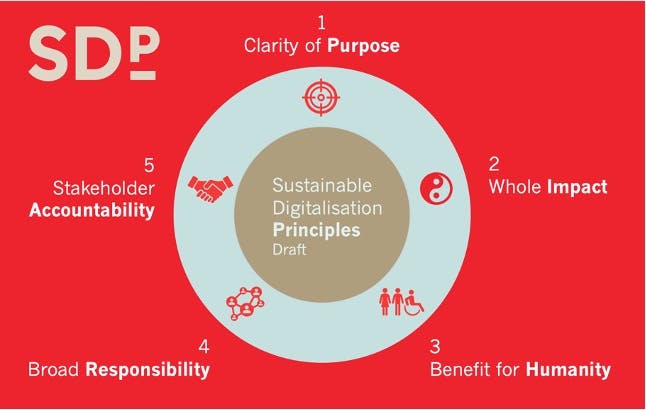Those that follow the World Economic Forum’s annual Global Risks Report will have observed the progressive rise over years of the climate change related risks to now top the rankings.
Another trend that might have gone unnoticed is the rise in digital technology-related risks, such as digital inequality, cybersecurity failure and adverse tech advances.
The world is starting to realise that digital technology is a double-edged sword. From an environmental, social and governance (ESG) perspective it offers us great solutions along with significant risk of harm if not managed responsibly. It can either greatly improve or greatly degrade safety, well-being, inclusion or environmental performance.
It may be a big mistake to assume that, given digital technology offers so many great benefits, it should be pursued as quickly as possible and with minimum regard to ESG costs. Coal, oil and the automobile-centric city were once thought about in such a way.
Some governments have started to realise that technology cannot be adopted uncritically and have been working to introduce checks and balances in a careful and considered fashion.
For example, the NSW government’s Department of Customer Service has put ethics and trust front and centre of its digital transformation. The agency realises that without it its ability to deliver useful digital services to the public may be compromised.
Investors have also started to show concern. On the back of the 2019 Christchurch massacre, a consortium of investors representing NZ$5 trillion of assets backed the Christchurch Call to eliminate terrorist and violent extremist content online. It was seen as material to the value of their social media company holdings.
The Sustainable Digitalisation Project (SDP) – a collaboration from industry, academia and government – is doing similar work for the built environment; working to establish a responsible, ethical and sustainable future with digital tech.

The 5 Sustainable Digitalisation Principles. Image: SDP
The Sustainable Digitalisation Principles are out for consultation
The SDP has released the following draft set of Sustainable Digitalisation Principles to provide the overarching framework for a responsible, ethical and sustainable approach to digitalisation in the built environment.
1. Clarity of purpose
The reasons for the development or use of the digital technology are carefully considered and made clear to users and other potentially impacted stakeholders.
2. Whole impact
Harm associated with the use of the digital technology is avoided, and social, environmental and governance benefits are sought.
3. Benefit for humanity
The fundamental experience of being human is supported, including our dignity and human rights, as well as the qualities of healthy societies and culture, such as fairness, inclusion and diversity.
4. Broad responsibility
The scope of responsibility for environmental, social and governance issues associated with the digital technology covers the broader systems it is part of, its whole lifecycle and its supply chains.
5. Stakeholder accountability
Transparency and accountability to users and other stakeholders exist for environmental, social or governance issues arising out of the use of digital technology.
The principles work together as an integrated set, may be applied at the organisational or project level, and are applied to a degree commensurate with the level of ESG consequence involved.
Industry is getting behind their creation. This SDP initiative has been endorsed by the Australian Sustainable Built Environment Council (ASBEC), Facility Management Association (FMA), Green Building Council of Australia (GBCA), GRESB, Infrastructure Sustainability Council of Australia (ISCA), Property Council of Australia, Responsible Investment Association of Australia (RIAA) and Royal Institute of Chartered Surveyors (RICS).
How it works in practice
An example of how they might apply is the Safe Citizens app-based platform used to locate and communicate with people in disaster sites, such with a bomb blast or earthquake. It aids emergency response coordination and is designed to save lives.
Privacy was a first principle in its development and so, despite being in constant operation on users’ phones, they are 100 per cent anonymous. This has the benefit of ensuring that the app cannot be appropriated for surveillance by corporations or governments in the future.
As such, Safe Citizens is a digital technology that provides a social good (Benefit to Humanity) while also avoiding the direct risk of harm (Whole Impact) and pre-empting and mitigating harm in the future (Broad Responsibility).
The case of Sidewalk Labs
We might also reflect on the notable case of the proposed development in Toronto known as Sidewalk Toronto. Driven by Sidewalk Labs, Google’s sister urban analytics company, this development promised to be “built from the internet up”.
It did offer some remarkable environmental and social benefits, however, the community was alarmed by the possible use of citizens’ data, which affected its social license and the project was eventually abandoned mid-2020.
The use of the Sustainable Digitalisation Principles from the outset with Sidewalk Toronto may have led to a very different outcome for all parties – community, city, and developer – providing a framework for transparency and trust.
The drivers behind the project and its ESG benefits and risks would have been much clearer to all (Clarity of Purpose and Whole Impact) and the community could have had confidence in accountability from the outset (Stakeholder Accountability).
The adoption of the principles by the developers, operators, and owners of Australia’s built environment will give communities trust in digital technology initiatives and the organisations behind them, and customers confidence in the properties they use. It will reduce project, corporate, and investment risk.
However, these principles are only useful if industry adopts them successfully. While the SDP has consulted widely throughout the development of them, it wants to collect additional feedback from the professional community about their relevance and applicability.
Our hope is that the final version of these principles will underpin the safe and productive introduction of digital technology across the built environment, allowing industry, government, and the wider community to enjoy the benefits arising from a carefully constructed digital future.
The working paper on the principles is now available for feedback until 31 May 2021. This story was published with permission from The Fifth Estate.
Simon Carter is the founding chair of the Sustainable Digitalisation Project (SDP) and managing director of Morphosis. Jed Horner from Stone and Chalk and Dr James Meese from RMIT University also contributed to this article.


















